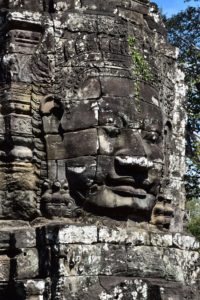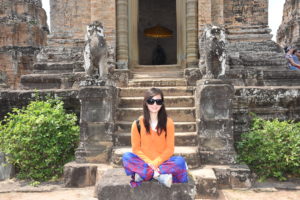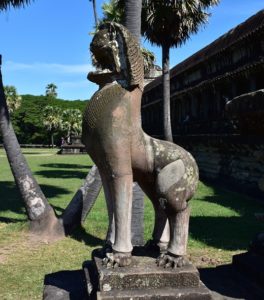 The poet has expressed in rather melancholic words ‘Time is a thief of precious life, never to be recovered’. The adage -that the ‘time is a thief’ is true every time. But it leaves its imprints on everything and it gives experience to humans as a return gift. At Angkor, however, these imprints are omnipresent ; some deliberately left by man whilst others by time itself. One wonders with utmost pain as to what kind was that stone hearted man who smited such fine pieces of art as carvings on the lintels of doors and The Idols of the Lord. My first brush with Angkor happened over three decades ago. Nothing seems to have improved ever since, though some efforts have indeed been made in that direction. Most telling has been deliberate damage by Khmer Rouge who decapitated lovely ‘sculptures in the round’ all over the place (I possess absolutely no courage whatsoever to show those heart-rending pictures in my work here) besides the other sculptures in bas or haute-reliefs.
The poet has expressed in rather melancholic words ‘Time is a thief of precious life, never to be recovered’. The adage -that the ‘time is a thief’ is true every time. But it leaves its imprints on everything and it gives experience to humans as a return gift. At Angkor, however, these imprints are omnipresent ; some deliberately left by man whilst others by time itself. One wonders with utmost pain as to what kind was that stone hearted man who smited such fine pieces of art as carvings on the lintels of doors and The Idols of the Lord. My first brush with Angkor happened over three decades ago. Nothing seems to have improved ever since, though some efforts have indeed been made in that direction. Most telling has been deliberate damage by Khmer Rouge who decapitated lovely ‘sculptures in the round’ all over the place (I possess absolutely no courage whatsoever to show those heart-rending pictures in my work here) besides the other sculptures in bas or haute-reliefs.
Not only that, structures have been brought down partially or totally. And what must have been magnificent is now left only for imagination of an onlooker. But let me warn everyone, as I have mentioned elsewhere as well, the intensity  of energy of any of the four dozen temples or so hasn’t diminished one tiny bit by this sacrilege. The sacredness has not lessened, anywhere, be it the Avlokiteshwaras, Lord Vishnu himself or The Nandi at Banteay Srei. Every piece still emanates charge that is palpable. No wonder, the entire humanity from far & wide reaches there pulled by that magnetism. And gets His Kind Blessings, still.
of energy of any of the four dozen temples or so hasn’t diminished one tiny bit by this sacrilege. The sacredness has not lessened, anywhere, be it the Avlokiteshwaras, Lord Vishnu himself or The Nandi at Banteay Srei. Every piece still emanates charge that is palpable. No wonder, the entire humanity from far & wide reaches there pulled by that magnetism. And gets His Kind Blessings, still.
Absolute lack of care & maintenance is the other imprint left on the masterpieces there. Patches of efflorescence and vines growing from within though might appear unworthy, but the serenity of Lord’s face still remains as charming; His gaze gently caressing us all still remains as benign as if the imprints of time haven’t affected His timelessness. At all.
If one starts naming, the Vasuki’s Seven Hoods are visible almost nowhere, though one can still see faint folds of the skin around His neck and scales at t he back of the hood. With great difficulty I could see at one or perhaps two places (I am not touching the restored ones at all here) as to what the original work might have been like. But, you might blame it on my untold devotion or lack of eye for detail that I could not see any blemish in Vasuki anywhere, irrespective of the omnipresent damage. To me what I see now, is the original.
he back of the hood. With great difficulty I could see at one or perhaps two places (I am not touching the restored ones at all here) as to what the original work might have been like. But, you might blame it on my untold devotion or lack of eye for detail that I could not see any blemish in Vasuki anywhere, irrespective of the omnipresent damage. To me what I see now, is the original.
Let me take a step back. In Indian philosophy, the Temples always are in a state of dynamic equilibrium, at any point in time. The devotee viewing the sculptures while moving in a trance like manner for the final tryst with his Lord, does not get to recognise what he sees. Or what quality  of workmanship in what he sees. He just sees Him and His energy radiating all around – through the walls, through the ceilings, through the doors, windows and columns; everything that he observes while ambulating. That is the bliss of being in a Temple. One does not scrutinise anything. He feels them as life-like; not as some pieces of stone or made up of brick & mortar arranged by master sculptors as ordered.
of workmanship in what he sees. He just sees Him and His energy radiating all around – through the walls, through the ceilings, through the doors, windows and columns; everything that he observes while ambulating. That is the bliss of being in a Temple. One does not scrutinise anything. He feels them as life-like; not as some pieces of stone or made up of brick & mortar arranged by master sculptors as ordered.
Since besides communion with The Lord, I have tasked myself to study & understand what had happened nearly a millennium ago, I go there again and again. And please trust me dear reader, I forget my purpose every ti me I go there. I come back with my work half done; every single time. And I am very definite there must surely be many more likes of me, for the beauty of Angkor is such. No one can remain untouched in his or her soul by that charm. At Angkor, all the work is at its magnificent best, which is an added feature of excellence of Angkor.
me I go there. I come back with my work half done; every single time. And I am very definite there must surely be many more likes of me, for the beauty of Angkor is such. No one can remain untouched in his or her soul by that charm. At Angkor, all the work is at its magnificent best, which is an added feature of excellence of Angkor.
Along with the Vasuki, the Serpent, Lion is the Protector at each place . But He too is in a similar state. And The Lions are in at least three forms. I read somewhere that in China they used to call a lion as ‘dog lion‘ entirely owing to the similarity between his appearance and that of Chihuahua, a dog species in China. And at Pre Rup especially, that is the truth – They appear like a Bull dog. But, the toll of time is identical.
. But He too is in a similar state. And The Lions are in at least three forms. I read somewhere that in China they used to call a lion as ‘dog lion‘ entirely owing to the similarity between his appearance and that of Chihuahua, a dog species in China. And at Pre Rup especially, that is the truth – They appear like a Bull dog. But, the toll of time is identical.
All in all, be it at the Bayon, Ta Prom where the Silk Cotton trees have been the main villains, Banteay Srei or Angkor Wat itself, the damage by everything that could have done the damage is widespread and visible. Wonder how it was in 1050 CE. How was it at its peak of excellence? Only He must have seen.